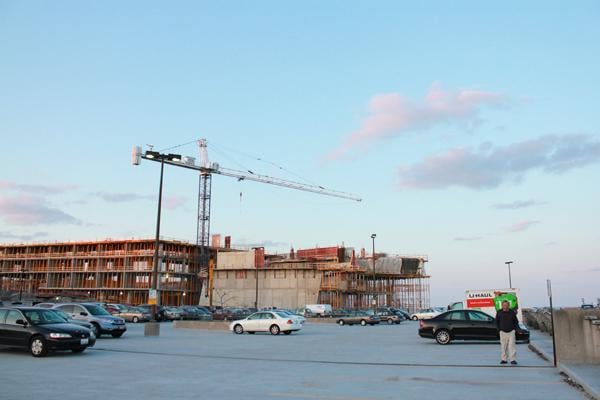
After a winter hiatus, the University picked back up with construction projects this quarter and began preparations for six new ones by the end of 2014.
In addition to ongoing work on the visitors center and the new performing arts center, NU will start upgrades to various existing buildings. Current and future construction projects over the next few years represent a campus-wide overhaul of the university’s academic, athletic and housing facilities that costs hundreds of millions of dollars.
Significant progress has been made on the new building for the Bienen School of Music and School of Communication, with structural framing completed for four of the five floors, said Bonnie Humphrey, director of design and construction for Facilities Management. The $117 million building, to be finished in the fall of 2015, will house administrative offices and a recital hall.
Work began this quarter on the expansion of the Henry Crown Sports Pavilion and Aquatics Center, as well as construction of an adjoining parking structure. Students must now enter SPAC from a south door as part of a permanent change to the structure, and much of the parking lot is now inaccessible.
A multipurpose recreation center, including a juice bar and sports medicine facilities, will occupy the first floor of the building, and the School of Communication’s speech and hearing clinics will relocate there from the Frances Searle Building. The first floor should be ready for use next summer, and parking will be available by February, said Ron Nayler, associate vice president of Facilities Management.
Although Nayler said work on the new visitors center is “well underway,” design took longer than expected. The garage will be operational at the beginning of 2014, and the visitors center should be occupied next summer, Nayler said.
“We spent a lot of time with the staff in the admissions office to try to determine what the best fit of space was and how to make it work,” Nayler said.
After a year of construction, the Mid-Campus Green next to Annenberg Hall will be finished this June, Humphrey said.
More major projects fast approaching
This summer, NU will demolish what it calls “Peanut Row” — several outdated fraternity houses on Lincoln Street left behind after this last year’s relocation of three chapters.
The site is under consideration to become a new residential area, Humphrey said. The former site of Roycemore School is also a potential site for new housing in the future.
The Technological Institute will grow even more this summer, with the addition of three new infills to form a new wing. Breaking ground next month, the project includes new lab space and imaging facilities. Estimated for completion in spring 2015, the renovations total $145 million.
Improvements will also be made this summer to Chapin Humanities Residential College, and Hobart House will undergo extensive renovation, totaling $10 to $11 million.
In the spring of 2014, the University will break ground on a new $288 million building for Kellogg and the Department of Economics. Currently in its design phase, the building already has “a decent chunk” of funding behind it from years of saving, said Jim Hurley, associate vice president for budget and planning. The use of the Jacobs Center is still under evaluation, but it will likely be repurposed for the social sciences, Humphrey said.
More space for academic departments
Although the North Campus parking structure will primarily serve athletics, the building will also house three graduate programs from the McCormick School of Engineering currently located in Tech.
“They’re kind of scattered all over the place,” said Ajit Tamhane, senior associate dean of McCormick. “Now we’re going to have a space that they can call their own.”
The renovation and expansion of Kresge Hall, beginning next summer, presents a greater logistical challenge. Facilities Management recently selected an architect for the $58 million project, which includes significant infrastructure updates to the nearly 60-year-old building, Humphrey said.
“Our project is a modernization program,” Humphrey said. “We will be vetting the whole building.”
Upgrades include mechanical system repairs that will add air conditioning and masonry restoration. Planners are also exploring a “reshuffling” of classrooms to the first two floors, Humphrey said.
University President Morton Schapiro said last week he was looking forward to the plans for Kresge, calling it “the new home for the humanities.”
“It’s going to be beautiful,” Schapiro said in an interview with The Daily. “It’s going to be gorgeous.”
Fundraising fuels construction
Current estimates for the dozen-plus ongoing and future construction projects combined top $1 billion.
The most expensive projects include the $231 million lakeside athletic complex and a $288 million new Kellogg building, as well as the recently unveiled proposal for a $150 million new student center. The majority of the construction is possible thanks to major fundraising efforts, as well as endowment and saving plans.
Coordinating funds for so many projects requires careful budgeting and strategic planning, Hurley said. Committees and business plans accompany every project, and efforts are made to integrate costs with the University’s overall budget, he said.
“We’ve got a lot of ambitions and it’s going to require a lot of funding,” Hurley said.



















